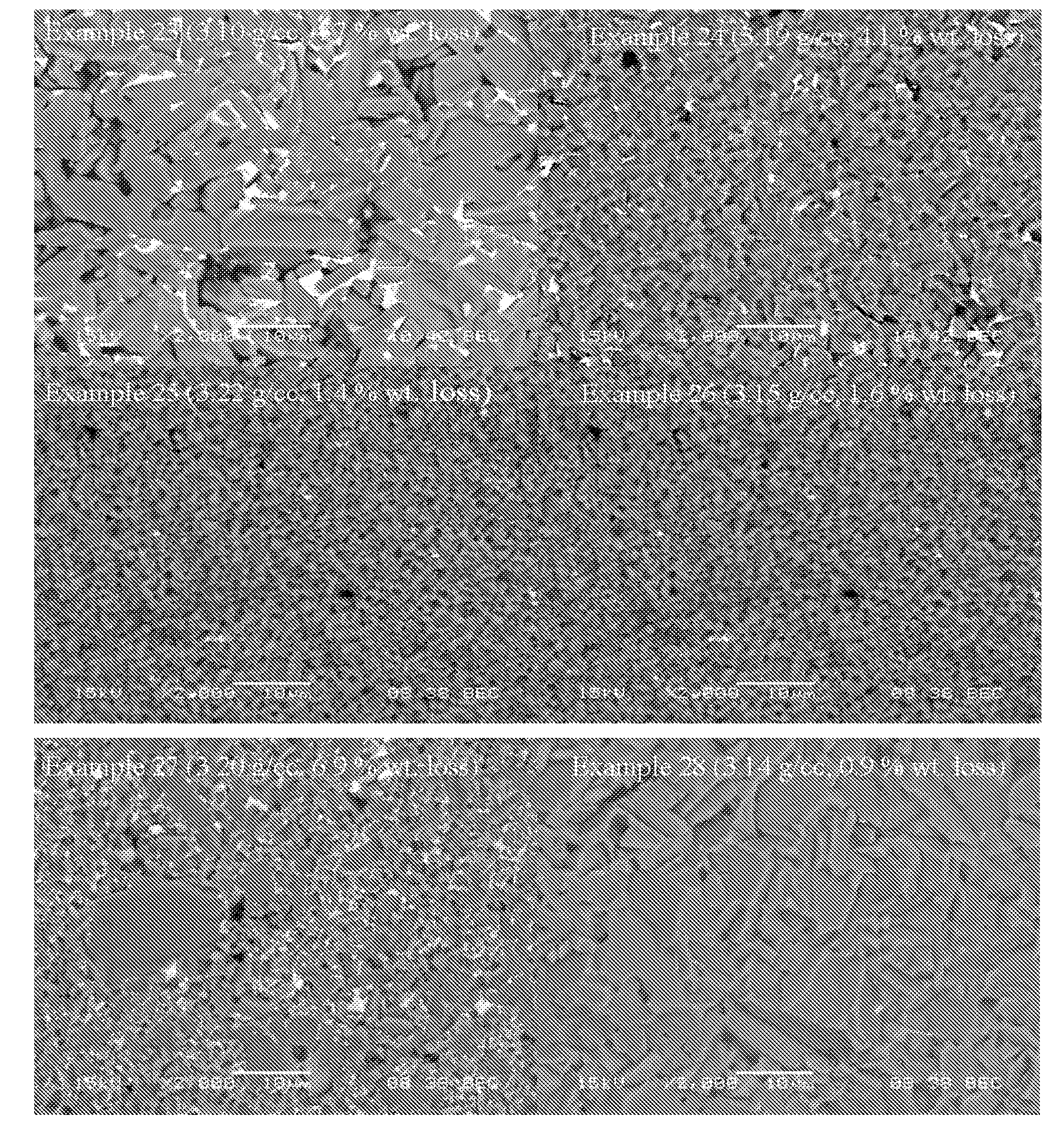Toughened Silicon Carbide and Method for Making the Same
- Summary
- Abstract
- Description
- Claims
- Application Information
AI Technical Summary
Benefits of technology
Problems solved by technology
Method used
Image
Examples
examples 1-8
[0055]Eight compositions were prepared by using alpha silicon carbide (H. C. Starck grade UF-15), boron carbide (H. C. Starck grade HS), phenolic resin (Durez Corporation grade 7716), aluminum (Valimet grade 1413), aluminum nitride (Tokuyama Soda grade F), yttrium oxide (Molycorp grade 5600), and reagent grade acetone. The compositions shown in Table 1 were prepared by making slurries of 350 grams of acetone and appropriate amounts of powdered phenolic resin (with a C content of 50% after pyrolysis), and powders so that each composition contained 300 g of powder based on a post-pyrolysis weight. The slurries were ball milled in one-liter high density polyethylene (HDPE) bottles filled with 1 kg of SiC (solid state sintered with boron and carbon additives) media for 62 hours. The slurry was then stir-dried and screened through an 80-mesh sieve. Following stir-drying, the powders were prepared for pressing by lubing with 2 wt. % polyethylene glycol (Union Carbide grade 8000) and 0.25 ...
example 9
[0059]A composition similar to Example 8 but with 0.5 wt. $ Y2O3 was prepared in larger quantities for pressing into large tiles. The powder (95.25wt. % SiC, 2.0 wt. % Al, 1.0 wt. % AlN, 1.0 wt. % C, 0.25 wt. % B4C, and 0.5 wt. % Y2O3) was made by batching slurries of 1500 grams using the same raw materials described in Examples 1-8. The slurries were ball milled in 4 liter HDPE bottle with 4 kg of SiC media for 16-20 hours. The slurries were then stir-dried and screened through a 20-mesh screen. Large plates (˜20 cmט30 cm) were pressed uniaxially at about 35 MPa and then isostatically pressed to 207 MPa. Pressed parts were delubed in an atmosphere of flowing N2 to 600° C. The green density of the plates (˜1.73 g / cc) was nearly identical that of the smaller tiles in Examples 1-8.
[0060]Large tiles were sintered between BN coated graphite foil, supported between graphite plates and placed nearly upright in a large graphite crucible with a lid. Due to size constraints, the tiles had t...
examples 10-16
[0061]The compositions shown in Table 4 were prepared in the same manner as Examples 1-8. For Example 16, Si3N4 (Ube, grade E-10) was substituted for the AlN at the same level of nitrogen as in Example 7, with additional Al added so that the Al contents were fixed for the two compositions. Tiles were pressed, debinderized, and sintered at 1925° C. for 1 hour in an identical manner as described for Examples 1-8. Weight loss was less than 2 wt. % for all samples. The samples were subsequently hot isostatically pressed (HIPed) by heating to 1950° C. and holding for one hour under 200
TABLE 4Compositions of Examples 10–16Mass (wt. %)ExampleSiCAlAlNC*B4CY2O3Si3N41095.252.01.01.00.50.250.01196.01.51.01.00.250.250.01295.751.51.01.00.50.250.01395.02.51.01.00.250.250.01494.752.51.01.00.50.250.01595.252.01.01.00.250.50.01695.012.660.00.720.250.50.86*After pyrolysis assuming a 50% char yield.
TABLE 5Shrinkage, Wt. Loss, and Density for Examples 10–16Wt.SEPB ToughnessShrinkageLossDensity (g / cc)(M...
PUM
| Property | Measurement | Unit |
|---|---|---|
| Temperature | aaaaa | aaaaa |
| Temperature | aaaaa | aaaaa |
| Percent by mass | aaaaa | aaaaa |
Abstract
Description
Claims
Application Information
 Login to View More
Login to View More - R&D
- Intellectual Property
- Life Sciences
- Materials
- Tech Scout
- Unparalleled Data Quality
- Higher Quality Content
- 60% Fewer Hallucinations
Browse by: Latest US Patents, China's latest patents, Technical Efficacy Thesaurus, Application Domain, Technology Topic, Popular Technical Reports.
© 2025 PatSnap. All rights reserved.Legal|Privacy policy|Modern Slavery Act Transparency Statement|Sitemap|About US| Contact US: help@patsnap.com



